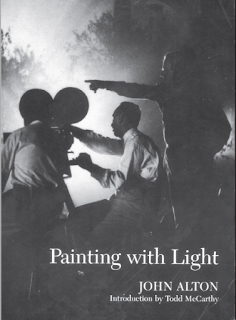"Painting With Light", John Alton
John Alton
(1901-1996) was a true master of light, one of the most respected cinematographers,
having left marks that characterized the cinema noir, notably through his collaborations with Anthony Mann [T-Men (1947), Raw Deal (1948)] and Joseph H. Lewis [The
Big Combo (1955)]. Alton also worked with Allan Dwan, Vincent Minnelli, Richard
Brooks, among others. His films are characterized by a high contrast black-and-white,
an astounding use of darkness in real locations, low angles with oblique lines
delineated in their compositions, suffocating fogs and intimidating silhouettes.
His book Painting Light was the first written by
a major Hollywood cameraman. In it, Alton explains how to get some lighting effects,
shooting techniques in different locations (exteriors or interiors) and climates, and the emotions that can arouse in the viewer through them. Even though
the technical materials of that time have suffered developments,
the theory in how to use them, that is, how to construct visual mood, has not aged.
Excerpts:
“Unless the
entire picture to be photographed is one flat surface, such as a plain wall, it
usually has a foreground and a background. The illusion of depth can be
enhanced by separation of the two; that is, if the foreground is dark, the
background should be light, or vice versa (Figs. 80, 81)."

"Photography, like music, has its psychological effect upon people. If we wanted to make someone laugh, we would hardly think of playing him a sad 'cello solo. In comedy photography, any lighting which might keep the audience from laughing must be avoided. A low-key scene might be upsetting and spoil the comedy effect."
Link to the complete book in PDF:
https://drive.google.com/file/d/1nJ-fhUINt8CQYZnNH9zIVFJ2upvYug4j/view?usp=sharing





Comments
Post a Comment